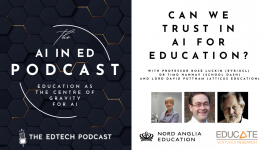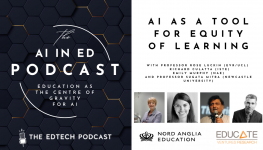The gap in education workforce decision making: Why data-driven insights are the key to elevating student outcomes

A guest blog post for The Edtech Podcast by PeopleBench Chief Education Officer, Dr Vicki Cameron.
As I moved my professional library, a large clunky computer and various other teacher items from my desk in a shared staffroom to my new corner office, I wondered if this was really happening. Dodging clumsy adolescents and their oversized bags in the corridor and being greeted by a cheery “morning miss” I stepped into the next phase of my career.
Little did I think that seven years later I would be working for an EdTech startup conducting virtual meetings with people all over the country from a laptop in my compact home office in the middle of a pandemic.
This journey began whilst I was on the school leadership team as the Head of Education. I realised that our greatest angst and greatest expense was recruitment and retention of quality teachers mediated by performance and development and the expertise missing from our leadership team was human resource management. Added to this, we had no data to indicate how school human resource practices impacted student outcomes.
I decided to commence my Master of Human Resource Management (MHRM). I had at times laboured over previous study but completing my MHRM was a watershed experience. Using the evidence informed HR practices of Shields (2007), Becker’s human capital theory and Kotter’s eight stages of organisational change l was able to immediately put my learning to use by developing and implementing a staff development framework.
Whilst I focused on teacher performance and development as part of a team of school leaders when I became the school principal, I was acutely aware that recruitment and selection of teachers was a principals most critical HR activity. The consequences of poor staffing decisions had consequences on student outcomes, school culture and the cost and complexity of all other HR processes are dependent upon getting this right.
It was also clear that having a well-planned workforce strategy to link recruitment and selection and the suite of HR processes to the strategic plan was essential to the achievement of the school’s strategic goals. What was missing was any school workforce data to inform developing a workforce strategy.
Consequently, without a second thought I embarked on a doctorate entitled Human Resource Management in Education: Recruitment and Selection of Teachers. This was a far greater undertaking than I had anticipated, buoyed on by the absence of educational data and analytics in this area and a highly supportive supervisor I persisted. I found some synergy with the data revealed by Darling-Hammond (2010) who linked student outcomes to teacher turnover and Hanushek (2011) whose predictive analytics on teacher quality revealed the long-term economic benefits of the impact of better student outcomes due to improved teacher quality.
Throughout this time, I continually questioned why schools and school systems have not explored data driven technology solutions to inform workforce decisions. Evidence from other industries indicates that technological and data driven HR solutions can remove the subjectivity and bias that is often present in recruitment and selection and workforce planning and deliver insightful results.
Education has always been heavily paper based and face-to-face in delivery, COVID-19 has given us the opportunity to hone our technology skills and quickly adapt to online teaching and learning using technology that has been readily available but remarkably under-utilised.
Hopefully one positive to evolve from this strange time is a greater use of data and technology solutions in education not only for teaching and learning but to inform school workforce decisions.
I still miss hearing that cheery adolescent “morning miss” each morning but I wouldn’t change the amazing journey that has brought me to the intersection of education, data and technology.
References
Appelbaum, S.H., Habashy, S., Malo, J-L., & Shafiq, H. (2012). Back to the future: revisiting Kotter’s 1996 change model. Journal of Management Development, 31(8), 764-782. doi:10.1108/02621711211253231
Becker, G. (1975). Human Capital. New York Columbia University Press.
Darling-Hammond, L. . (2010). Recruiting and Retaining Teachers: Turning Around the Race to the Bottom in High-Need Schools. Journal of Curriculum and Instruction, 4(1), 16-32. doi:10.3776/joci.2010.v4n1p16-32
Hanushek, E.A. (2011). The economic value of higher teacher quality. Economics of Education Review, 30(3), 466-479. doi:10.1016/j.econedurev.2010.12.006
Shields, J. (2007). Managing Employee Performance and Reward. Melbourne: Cambridge University Press.
About the author
Dr Vicki Cameron
 Dr Cameron is an expert in school workforce management with extensive experience across an array of capacities within the education sector. Dr Cameron holds a Doctorate in Teacher Recruitment and Selection, a Masters in Human Resource Management, was an early adopter and leader in teacher Professional Standards and Workforce Strategy and holds many years of experience in school leadership and teaching across both primary and secondary settings.
Dr Cameron is an expert in school workforce management with extensive experience across an array of capacities within the education sector. Dr Cameron holds a Doctorate in Teacher Recruitment and Selection, a Masters in Human Resource Management, was an early adopter and leader in teacher Professional Standards and Workforce Strategy and holds many years of experience in school leadership and teaching across both primary and secondary settings.
With her sought-after skill set, Dr Cameron is elevating student outcomes through teacher workforce data and analytics in her role as Chief Education Officer at PeopleBench.
About PeopleBench
PeopleBench is a workforce analytics and research company in the K-12 education sector. They provide leaders in the sector with the research, insights, tools – and ultimately the confidence – to make well-informed decisions about their school workforce, with the best possible outcomes for students at the heart of it all. By providing these services, PeopleBench contributes to raising the standard of workforce management practice sector-wide, to the benefit of school leaders, teachers and students across the world.



